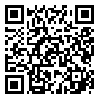BibTeX | RIS | EndNote | Medlars | ProCite | Reference Manager | RefWorks
Send citation to:
URL: http://jdisabilstud.org/article-1-2873-fa.html


 ، بهمن اکبری*2
، بهمن اکبری*2 

 ، عباس صادقی3
، عباس صادقی3 

 ، مهوش مافی4
، مهوش مافی4 


2- استاد، گروه روانشناسی، واحد رشت، دانشگاه آزاد اسلامی، رشت، ایران
3- دانشیار، گروه مشاوره، دانشگاه گیلان، رشت، ایران
4- دانشیار، گروه روانشناسی بالینی، واحد لاهیجان، دانشگاه آزاد اسلامی، لاهیجان، ایران
زمینه و هدف: رفتارهای پرخطر یکی از پدیدههای دورهٔ نوجوانی است و عوامل متعددی زمینهساز آن بهشمار میرود. هدف پژوهش حاضر، تعیین مدل ساختاری روابط کارکرد خانواده با رفتارهای پرخطر نوجوانان دورۀ دوم متوسطه با نقش واسطهای کیفیت زندگی در مدرسه بود.
روشبررسی: روش پژوهش حاضر تحلیلی و از نوع همبستگی برمبنای مدلسازی معادلات ساختاری بود. جامعهٔ آماری پژوهش را دانشآموزان دورهٔ دوم متوسطهٔ استان قزوین در سال تحصیلی ۱۴۰۰-۱۳۹۹ تشکیل دادند. نهصد نفر بهروش نمونهگیری خوشهای انتخاب شدند. برای گردآوری دادهها، مقیاس رفتار پرخطر نوجوانان ایرانی (زاده محمدی و همکاران، ۱۳۹۰)، مقیاس عوامل خطرساز و حفاظتکنندهٔ مصرف مواد (محمدخانی، ۱۳۸۷) و مقیاس کیفیت زندگی در مدرسه (سلطانی شال و همکاران، ۱۳۹۰) بهکار رفت. تحلیل دادهها در سطح معناداری ۰٫۰۱ و با استفاده از روشهای آمار توصیفی و استنباطی (ضریب همبستگی پیرسون و مدلسازی معادلات ساختاری) در نرمافزارهای SPSS و AMOS صورت گرفت.
یافتهها: در مدل برازش دادهشده، ضریب مسیر کل بین کارکرد خانواده با رفتارهای پرخطر (۰٫۰۰۱>p، ۰٫۶۲۸-=β) منفی و معنادار بهدست آمد. ضریب مسیر مستقیم بین کارکرد خانواده با رفتارهای پرخطر (۰٫۰۰۱>p، ۰٫۴۳-=β) و ضریب مسیر مستقیم کیفیت زندگی در مدرسه با رفتارهای پرخطر (۰٫۰۰۱>p، ۰٫۳۶-=β) منفی و معنادار بود. ضریب مسیر مستقیم کارکرد خانواده با ﮐﯿﻔﯿﺖ زﻧﺪﮔﯽ در مدرسه (۰٫۰۰۱>p، ۰٫۵۵=β) مثبت و معنادار و ضریب مسیر غیرمستقیم کارکرد خانواده با رفتارهای پرخطر (۰٫۰۰۱>p، ۰٫۱۹۵-=β) منفی و معنادار بهدست آمد. شاخصهای نکویی برازش دادههای گردآوریشده (۰٫۰۵۶=RMSEA، ۲٫۵۸=X2/dF، ۰٫۹۷=CFI، ۰٫۹۶=GFI، ۰٫۹۳=AGFI) نشان داد، مدل از برازش مطلوبی برخوردار بود.
نتیجهگیری: براساس یافتههای این پژوهش، کارکرد خانواده نقش تعیینکنندهای در رفتارهای پرخطر نوجوانان دارد؛ همچنین کیفیت زندگی در مدرسه بین کارکرد خانواده با رفتارهای پرخطر بهصورت معناداری میانجیگری میکند.
| بازنشر اطلاعات | |
 |
این مقاله تحت شرایط Creative Commons Attribution-NonCommercial 4.0 International License قابل بازنشر است. |


